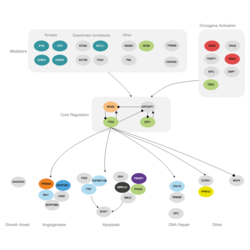p53 is one of the most prominent tumor suppressors and is often called “the guardian of the genome”. Mutations of p53 or parts of its regulatory circuit are found in almost all cancers, which highlights its importance. It is conserving the stability of the genome by preventing mutations caused by cellular stress or DNA damage. p53 stabilizes the genome by regulating the expression of a wide variety of genes involved in Apoptosis, Inhibition of cell cycle progression, Differentiation, Growth arrest and accelerated DNA repair.
p53 is a sequence-specific DNAbinding transcription factor which is maintained at low levels in mammalian cells which are not under cellular stress since p53 has a very short half-life. This is achieved through the continuous ubiquitination of p53 by its suppressor MDM2 and its subsequent degradation by the 26S Proteasome. Signals of cellular stress, like for example DNA damage, suppress the ubiquitylation of p53 and lead to its stabilization and activation. Once p53 is activated it binds to the regulatory elements of its downstream targets and regulates their transcription. This in turn starts several cellular programs which account for the different tumor-suppressing functions of p53.
Written/Edited by Dr. Stefan Pellenz, PhD
You are here:





